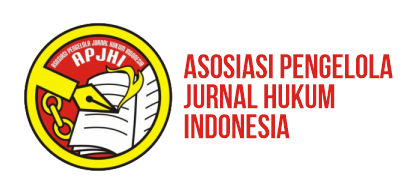Dekonstruksi Kewenangan Investigatif dalam Pelanggaran Hak Asasi Manusia yang Berat
DOI:
https://doi.org/10.31078/jk1647Keywords:
Dekonstruksi, Relasi Penyelidikan dan Penyidikan, Pelanggaran HAM yang Berat.Abstract
Relasi fungsi Komnas HAM sebagai penyelidik dan Jaksa Agung sebagai penyidik, menyisakan ruang pedebatan yang menyandera penyelesaian pelanggaran HAM yang berat. Bersamaan dengan itu Putusan MK No.75/PUU-XII/2015 yang menguji frasa “kurang lengkap..” Pasal 20 (3) UU Pengadilan HAM, menegaskan bahwa bolak balik berkas, merupakan implikasi dari masalah dalam penerapan norma dalam praktik. Sedangkan konsekuensi dari frasa tersebut menyasar pada lingkup pemeriksaan bukti dan peristiwa. Kajian ini berupaya mengurai praktik penyelidikan dan penyidikan pelanggaran HAM, dengan menganalisis relasi antara kedua kewenangan tersebut. Pendekatan peraturan perundang-undangan, pendekatan konseptual, menjadi lingkup analisis yang membantu untuk menjawab isu hukum. Kajian ini menemukan bahwa penggunaan frasa dan penafsirannya melahirkan friksi dalam penerapan norma. Untuk mengurai hal tersebut dilakukan dengan memetakan praktik dari bolak balik berkas. Perbedaan penafsiran ditemukan pada melebarnya hasil penyelidikan hingga penuntutan, yang berujung pada perbedaan klasifikasi jenis pidana. Temuan berupa ketidaksesuaian penerapan norma, merupakan konsekuensi dari praktik model hierarki dihadapkan pada otoritas kewenangan yang terpisah. Alhasil bentuk prosedur yang dipertanyakan, berkutat pada prosedur yang ada tanpa melihat karakter khusus dari situasi, peristiwa, kejahatan. Berlanjut dari itu anomali dalam praktik menjadikan penggunaan model hierarki dan model koordinasi dalam investigasi mengaburkan proses penyelesaian pelanggaran HAM yang berat. Berkaca pada proses di ICC terdapat beberapa hal yang bisa diambil untuk memperkaya wacana proses penyelesaian pelanggaran HAM yang berat.The relation between the functions investigation of the National Human Rights Commission and the Attorney General leaves a space for debate that holds hostage to completion of gross human rights violations. At the same time, the Constitutional Court Decision No. 75/PUU-XII/2015 which examines the phrase "incomplete..." Article 20 (3) of the Law on Human Rights Courts, emphasizes that back and forth files are the implications of problems in applying norms in practice. While the consequences of these phrases target the scope of proofs and event examinations. This study seeks to unravel the practice of investigating human rights violations by analyzing the relations between the two authorities. Legislative approaches, conceptual approaches, historical approaches are the scope of analysis which helps to address legal issues. This study found that the use of phrases and their interpretations gave birth to friction in the application of norms. To parse this, it is done by mapping the practice of back and forth files. Differences in interpretation were found in the widening of the results of investigations to prosecution, which led to differences in the classification of criminal types. The findings in the form of incompatibility of norms are a consequence of the practice of hierarchical models faced with separate authority. As a result, the form of procedure is questioned, dwelling on existing procedures without seeing the special character of the situations, events, and the crimes. Continuing from that, anomalies in practice make the use of hierarchical models and coordination models in investigations obscure the process of resolving gross human rights violations. Reflecting on the process at the ICC, there are several things that can be taken to enrich the discourse on the process of completion gross human rights violations.
References
Cass R. Sunstein, 2006, “Two Conception of Procedural Fairnes”, Social Research, Vol. 73, No. 2, Fairness: Its Role in Our Lives, The John Hopskin University Press;
David Cohen, 2003, “Intended to Fail: The trials Before the Ad Hoc Human Rights Court in Jakarta”, International Center for Transtitional Justice. https://www.ictj.org/publication/intended-fail-trials-ad-hoc-human-rights-court-jakarta. Diakses pada 15 Juni 2018.
Enny Soeprapto, 2012, “Penyelidikan Menurut Hukum Acara Perkara Kejahatan Genosida dan Kejahatan Terhadap Kemanusiaan Menurut Undang-Undang No. 26 Tahun 2000 tentang Pengadilan Hak Asasi Manusia: Beberapa Catatan”, Makalah yang disiapkan untuk dipaparkan pada Rapat Sidang Paripurna Komnas HAM 9-10 Juli 2012.
F.Budiman Hardiman, 2003, Melampaui Positivisme dan Modernitas, Penerbit Kanisius, Yogyakarta;
Alex Gillespie and Flora Cornish, 2009, “Intersubjectivity: Towards a Dialogical Analysis.” Journal for The Theory of Social Behaviour 40:1 106 (3).
Harifin A. Tumpa, 2010, Peluang dan Tantangan Eksistensi Pengadilan HAM di Indonesia, Kencana, Jakarta.
Hilmar Farid dan Rikardo Simarmata, 2004, “The Struggle for Thruth and Justice”, International Center for Transnational Justice. https://www.ictj.org/publication/struggle-truth-and-justice. Diunduh Diakses 26 April 2018
Ifdhal Kasim, 2003, “UU Pengadilan Hak Asasi Manusia: Sebuah Tinjauan”, Makalah yang disampaikan pada Workshop “Merumuskan Amandemen UU Pengadilan HAM” yang diselenggarakan oleh PUSHAM-UII Yogyakarta, 26 Agustus 2003, ELSAM.
Megumi Ochi, 2016, “Gravity Treshold Before The International Criminal Court: An Overviewof The Court’s Practice”, ICD Brief 19, International Crime Database. http://www.internationalcrimesdatabase.org/upload/documents/20160111T115040-chi%20ICD%20Format.pdf. diunduh pada 28 Maret 2018.
Margaret M.deGuzman, 2008, “Gravity and Legitimacy of The International Criminal Court”, Fordham International Law Jurnal, Volume 32, Issue 5, Article 2.
Marwan Effendi, 2005, Kejaksaan RI Posisi dan Fungsinya dari Perspektif Hukum, Jakarta, Gramedia Pustaka Utama.
Mirjan Damaska, 1975, ” Structure of Authority and Comparative Criminal Procedure”, The Yale Law Journal, Vol 82, No. 3.
Office of the Prosecutor, 2013, “Policy Paper on Preliminary Examinations”, International Criminal Court. https://www.icc-cpi.int//Pages/item.aspx?name=otp-policy-pe-11_2013. Diakses pada 20 Juni 2018.
Office of the Prosecutor, 2017, “Report on Preliminary Examination Activities”, International Criminal Court. https://www.icc-cpi.int//Pages/item.aspx?name=171204-rep-otp-PE diakses pada 20 Juni 2018.
SáCouto, Susana and Katherine A. Cleary, 2008, “The Gravity Threshold of the International Criminal Court”, American Journal of International Law 23, no. 5.
Veresha, R. V., 2016, “Mistake Of Criminal Law And Its Influence On The Classification Of Crime”, International Journal Of Environmental & Science Education, Volume 11, Issue 15.
Undang-Undang No. 39 Tahun 1999 tentang Hak Asasi Manusia
Undang-Undang No. 26 Tahun 2000 tentang Pengadilan Hak Asasi Manusia
Putusan Mahkamah Konstitusi No. 75/PUU-XIII/2015;
Putusan Mahkamah Konstitusi No. 18/PUU-V/2007;
Roma Statute of the International Criminal Court/Statuta Roma;
Rule of Procedure and Evidence;
Notulensi Diskusi Kelompok Terfokus mengenai “Dekonstruksi Hukum Acara Pengadilan HAM”, tanggal 12 Juli 2018 di Komnas HAM.
Downloads
Published
How to Cite
Issue
Section
License
Authors who publish with this journal agree to the following terms:
- Copyright of the published articles will be transferred to the journal as the publisher of the manuscripts. Therefore, the author confirms that the copyright has been managed by the publisher.
- The publisher of Jurnal Konstitusi is The Registrar and Secretariat General of the Constitutional Court of the Republic of Indonesia.
- The copyright follows Creative Commons Attribution-NonCommercial-ShareAlike 4.0 International License: This license allows reusers to distribute, remix, adapt, and build upon the material in any medium or format for noncommercial purposes only, and only so long as attribution is given to the creator. If you remix, adapt, or build upon the material, you must license the modified material under identical terms.

















